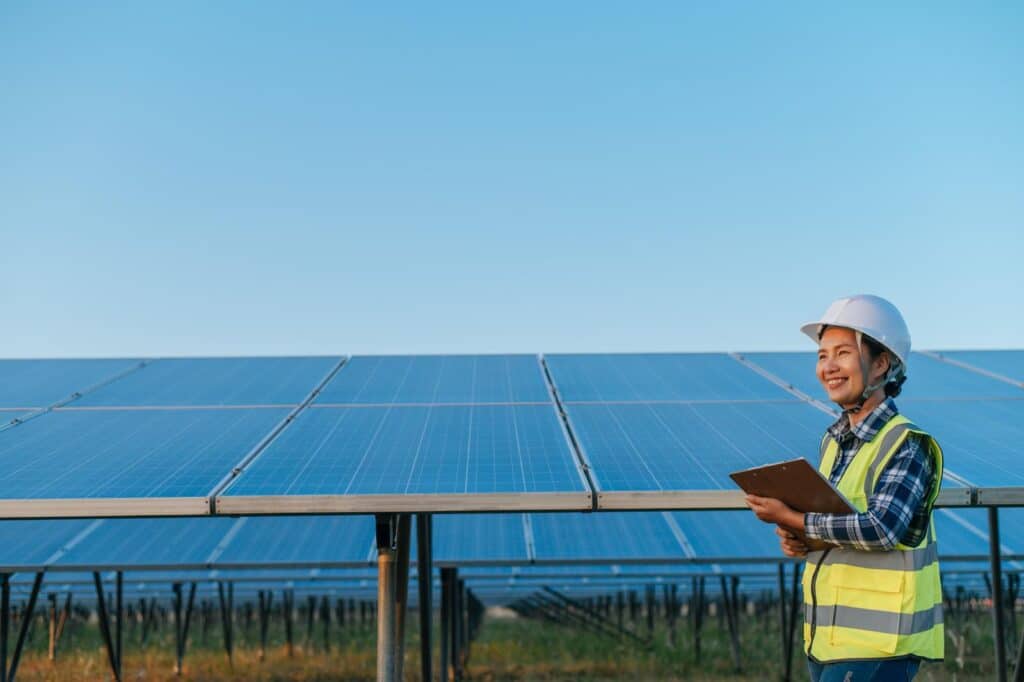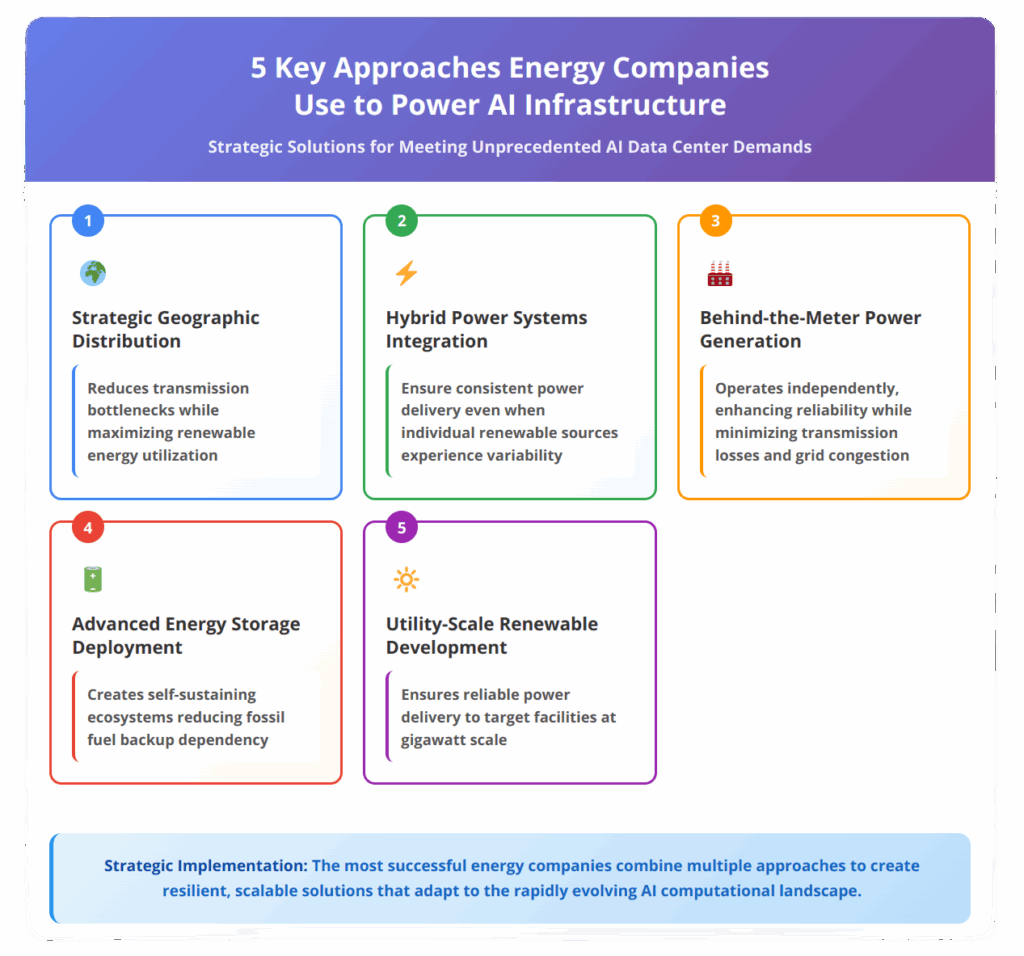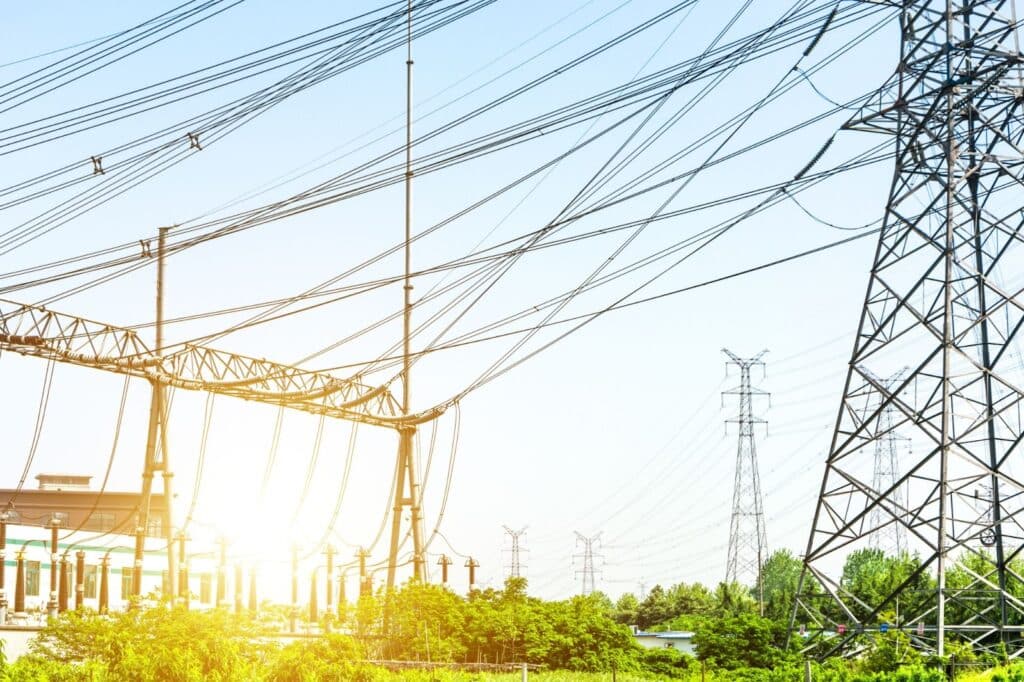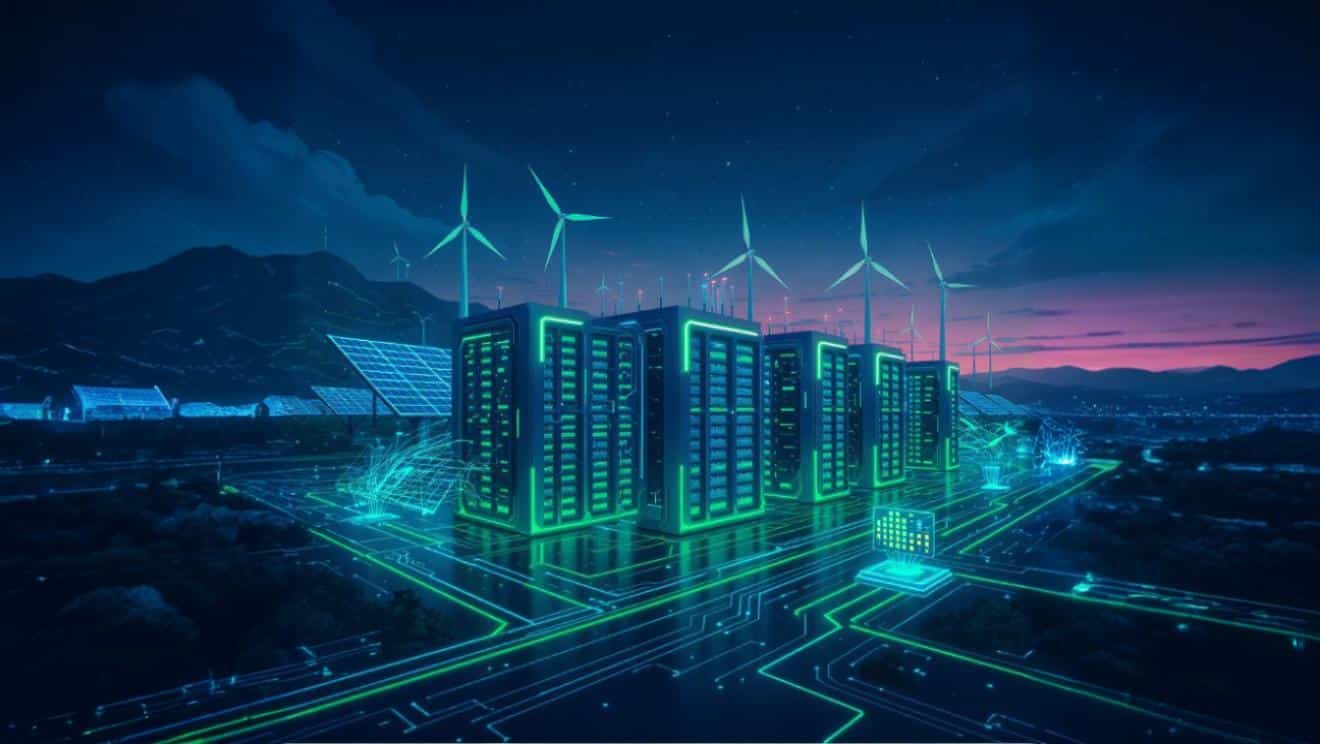The artificial intelligence revolution is reshaping our digital landscape, but it’s also creating an unprecedented energy challenge. Data centers are projected to consume 945 terawatt-hours by 2030, roughly equivalent to Japan’s entire annual electricity consumption. This explosive growth is forcing a fundamental reimagining of how leading energy companies and other forward-thinking infrastructure developers approach project development.
AI data centers’ power requirements are evolving. Unlike traditional data centers that might consume 30 megawatts, modern AI facilities demand 200 megawatts or more, with individual GPU clusters pulling upwards of 80 kilowatts per rack. The stakes couldn’t be higher for energy companies to deliver reliable, scalable, and increasingly sustainable power solutions.
The Exponential Growth of AI Data Center Power Needs
The numbers behind AI’s energy appetite are staggering. According to Goldman Sachs Research, global power demand from data centers will increase by as much as 165% by the end of the decade compared to 2023 levels. This surge is driven by the computational intensity of training large language models and running real-time AI inference at scale.

What makes AI data centers’ power consumption particularly challenging is its continuous nature. Traditional enterprise workloads might peak and drop throughout the day, but AI training sessions and inference operations often run around the clock. A single ChatGPT query requires 2.9 watt-hours of electricity compared to just 0.3 watt-hours for a standard Google search, illustrating the magnitude of this shift.
The geographic concentration of this demand is equally striking. Northern Virginia, dubbed the “data capital of the world,” houses more than 250 facilities with a combined capacity of 3.4 gigawatts. The region’s vacancy rate has plummeted to less than 1%, creating intense pressure on energy infrastructure and grid capacity.
These facilities also generate extreme heat that standard air cooling systems cannot handle. Cooling accounts for approximately 40% of a data center’s total electricity consumption, pushing energy companies for AI data centers to develop more sophisticated thermal management solutions alongside their power delivery strategies.
How Leading Energy Companies Are Responding
Major energy companies are stepping up with unprecedented renewable energy commitments to meet these demands. The response has been swift and massive in scale, with corporate procurement of clean energy reaching new heights across the industry.
Amazon leads the pack with 30.9 terawatt-hours consumed across its operations in 2021, with 85% coming from renewable sources. The company aims to reach 100% renewables by 2025 and has signed supply agreements with more than 100 solar and wind projects globally. Microsoft isn’t far behind, having contracted 5.7 gigawatts of renewable capacity and announcing plans to invest $80 billion in data center expansion this year alone.
Google’s approach exemplifies the strategic thinking driving this transformation. The company recently unveiled a $20 billion partnership with Intersect Power and TPG Rise Climate to develop industrial parks that co-locate gigawatts of data center capacity with clean energy plants. This “power first” approach prioritizes renewable energy availability in site selection rather than treating it as an afterthought.
The technology sector now dominates corporate renewable procurement, accounting for more than 68% of nearly 200 deals tracked over the 12 months prior to February 2024. These aren’t small commitments either. Microsoft’s deal with Brookfield Asset Management alone covers the delivery of 10.5 gigawatts of renewable energy between 2026 and 2030.
Energy solutions for data centers are becoming increasingly sophisticated, with companies pursuing multiple approaches simultaneously. Direct power purchase agreements (PPAs) provide long-term cost predictability, while on-site generation through solar and battery storage offers energy security and reduced transmission losses.

5 Key Approaches Energy Companies Use to Power AI Infrastructure
The scale and complexity of AI data center power requirements have fundamentally altered how energy companies approach infrastructure development. Traditional utility-scale projects were designed around predictable, gradual load growth, but AI facilities can appear seemingly overnight with massive, continuous power demands that exceed entire city grids. This shift has forced energy companies to completely rethink their development strategies, moving from reactive power provision to proactive, integrated infrastructure planning.
Smart energy companies recognize that success in the AI data center market requires more than simply scaling up existing renewable projects. They need sophisticated approaches that address the unique challenges of 24/7 computational loads, extreme power densities, and the geographic constraints of existing grid infrastructure. The companies thriving in this space are those that have developed comprehensive strategies encompassing everything from site selection and resource optimization to advanced storage integration and grid-independent operations.
The following five approaches represent the core strategies that leading energy companies for AI data centers are deploying to meet these unprecedented demands. Each approach addresses specific aspects of the AI power challenge, but the most successful implementations combine multiple strategies to create resilient, scalable energy solutions that can adapt to the rapidly evolving computational landscape.
Energy companies are deploying diverse strategies to meet the unique demands of AI data center power requirements:
1. Strategic Geographic Distribution
Smart energy companies are identifying locations where renewable resources are most abundant and reliable. West Texas, with its exceptional wind resources, and the Southeast, with strong solar potential, are becoming preferred sites for new developments. This approach reduces transmission bottlenecks while maximizing renewable energy utilization.
2. Hybrid Power Systems Integration
Advanced energy solutions for data centers now combine multiple renewable sources with energy storage. Solar farms charge battery systems during peak production hours, while wind generators provide complementary generation profiles. This hybrid approach ensures consistent power delivery even when individual renewable sources experience variability.
3. Behind-the-Meter Power Generation
Forward-thinking energy companies are developing on-site renewable generation that directly serves data center loads without relying on grid transmission. These systems can operate independently when needed, enhancing reliability while minimizing transmission losses and grid congestion.
4. Advanced Energy Storage Deployment
Battery energy storage systems are bridging the gap between intermittent renewable generation and continuous AI workloads. These systems store excess energy during low-demand periods and release it during spikes, creating self-sustaining energy ecosystems that reduce dependency on fossil fuel backup generation.
5. Utility-Scale Renewable Development
Energy companies are developing massive solar and wind farms specifically designed to serve data center loads. These projects often exceed 500 megawatts in capacity and include dedicated transmission infrastructure to ensure reliable power delivery to their target facilities.

Renewable Technologies Driving the Transformation
Solar power has emerged as a cornerstone technology for AI data center power solutions. Large-scale solar installations now deliver electricity at costs competitive with traditional generation while providing predictable pricing for long-term planning. Modern solar farms incorporate advanced tracking systems that maximize energy production throughout the day.
Wind energy offers an ideal complement to solar generation, creating more balanced renewable energy profiles. Wind resources often peak at different times than solar production, while offshore wind development is expanding rapidly, with projects demonstrating coastal market potential.
Energy storage technology has reached a tipping point where it serves as the primary power infrastructure. Advanced lithium-ion battery systems can discharge for 4-8 hours at full capacity, providing sufficient duration to bridge renewable generation gaps. Some projects are exploring longer-duration storage technologies for extended energy security.
Nuclear power is experiencing renewed interest as a carbon-free baseload complement to renewable energy. Small modular reactors (SMRs) offer dedicated data center power potential without massive infrastructure requirements. Microsoft’s Three Mile Island partnership demonstrates how seriously technology companies view nuclear energy.
Overcoming Infrastructure and Grid Challenges
The rapid growth in AI data center power demand is straining existing grid infrastructure in ways the electricity system was never designed to handle. Traditional power grids were built for gradual, predictable load growth, not the sudden appearance of facilities requiring hundreds of megawatts of continuous power.
Transmission constraints represent one of the most significant bottlenecks facing energy companies for AI data centers. In popular markets like Northern Virginia and Silicon Valley, wait times for new grid connections can exceed five years. Supply chain disruptions for critical components like transformers and switchgear are creating additional delays, with lead times extending 12-18 months beyond historical norms.
Energy companies are responding with innovative solutions that bypass traditional grid limitations:
• Microgrid Development: Self-contained energy networks that can operate independently from the main grid, providing enhanced reliability and reducing transmission requirements.
• Direct Interconnection: Dedicated transmission lines that connect renewable generation directly to data center loads, avoiding congested transmission corridors.
• Energy Campus Planning: Integrated developments that co-locate renewable generation, energy storage, and data center infrastructure on the same site or in close proximity.
Competition for renewable energy resources adds another layer of complexity. As more industries pursue decarbonization goals, the available pool of renewable energy credits and long-term power purchase agreements is becoming increasingly constrained. This dynamic is driving energy companies to develop larger, more efficient projects that can serve multiple customers simultaneously.
Grid modernization efforts are underway in key markets, but these infrastructure upgrades take years to complete. Forward-thinking energy companies are working closely with utilities and regulators to identify priority transmission projects that will unlock renewable energy potential for data center development.

The Future of Energy and Data Center Partnerships
The relationship between energy companies and data center operators is evolving from simple power purchases to strategic partnerships encompassing site selection, infrastructure development, and long-term capacity planning. Energy availability is becoming as important as fiber connectivity and proximity to population centers.
Digital infrastructure provider relationships are becoming more collaborative, with energy companies participating in early-stage planning. Rather than responding to power requests after site selection, energy companies help identify optimal locations based on renewable resource availability and transmission capacity.
Advanced energy analytics enable sophisticated demand forecasting and capacity planning. Machine learning algorithms predict data center consumption patterns based on workloads, weather, and market dynamics, allowing energy companies to optimize investments for maximum efficiency.
Regulatory frameworks are adapting to support new partnership models. States are streamlining environmental reviews for renewable projects serving data centers, while, in the past, tax incentives encouraged integrated development approaches. New legislation may change that, eliminating tax credits for solar and wind projects.
Energy-as-a-service models create opportunities for comprehensive partnerships. Rather than simply selling electricity, energy companies offer complete solutions including generation, storage, transmission, and management services.
Building Tomorrow’s Energy Infrastructure Today
The transformation of how energy companies power AI data centers represents one of the most significant infrastructure challenges and opportunities of our time. As artificial intelligence continues to reshape industries and society, the companies that successfully bridge energy innovation with digital infrastructure will define the sustainable future of our connected world.
The path forward requires unprecedented collaboration between energy developers, technology companies, and policymakers to ensure that our AI-powered future is built on a foundation of clean, reliable, and scalable energy infrastructure. For organizations planning AI infrastructure investments, partnering with experienced energy companies that understand both renewable energy development and data center power requirements is becoming essential for long-term success. Get started with 174 Power Global to explore comprehensive energy solutions for your next data center project.
Frequently Asked Questions
What makes AI data centers different from traditional data centers in terms of power requirements?
AI data centers require significantly more power density and continuous operation than traditional facilities. While a typical data center might consume 30 megawatts, modern AI facilities demand 200+ megawatts, with individual GPU clusters drawing 80+ kilowatts per rack. AI workloads also run continuously for training and inference, requiring 24/7 power availability without the load variability seen in traditional enterprise computing.
How are energy companies ensuring renewable power can meet the 24/7 demands of AI data centers?
Energy companies are deploying hybrid renewable systems that combine solar, wind, and advanced battery storage to provide consistent power delivery. These systems include sophisticated energy management platforms that predict renewable generation and optimize storage discharge to maintain continuous operation. Many companies are also developing dedicated transmission infrastructure and exploring nuclear power as a carbon-free baseload complement.
What role does energy storage play in powering AI data centers with renewable energy?
Energy storage is critical for bridging the gap between intermittent renewable generation and constant AI power demands. Modern battery systems can store excess solar and wind energy during peak production periods and release it during low generation or high demand periods. Advanced storage deployments can provide 4-8 hours of full-capacity discharge, with some projects exploring longer-duration technologies for extended energy security.
How do energy companies address grid constraints when developing power solutions for AI data centers?
Energy companies are developing innovative solutions, including microgrids, direct interconnection agreements, and energy campus developments that reduce reliance on constrained transmission infrastructure. Some are co-locating renewable generation with data centers to minimize transmission requirements, while others are investing in dedicated transmission lines and working with utilities on priority grid modernization projects.
What geographic factors influence where energy companies can successfully power AI data centers?
Key geographic considerations include renewable resource availability (strong solar in the Southeast, excellent wind in the Midwest), existing transmission infrastructure, regulatory environments, and proximity to fiber networks. Energy companies are increasingly focusing on areas with abundant renewable resources and supportive utility relationships, such as Texas, Virginia, and parts of the Mountain West, where they can develop comprehensive energy solutions for data centers.



